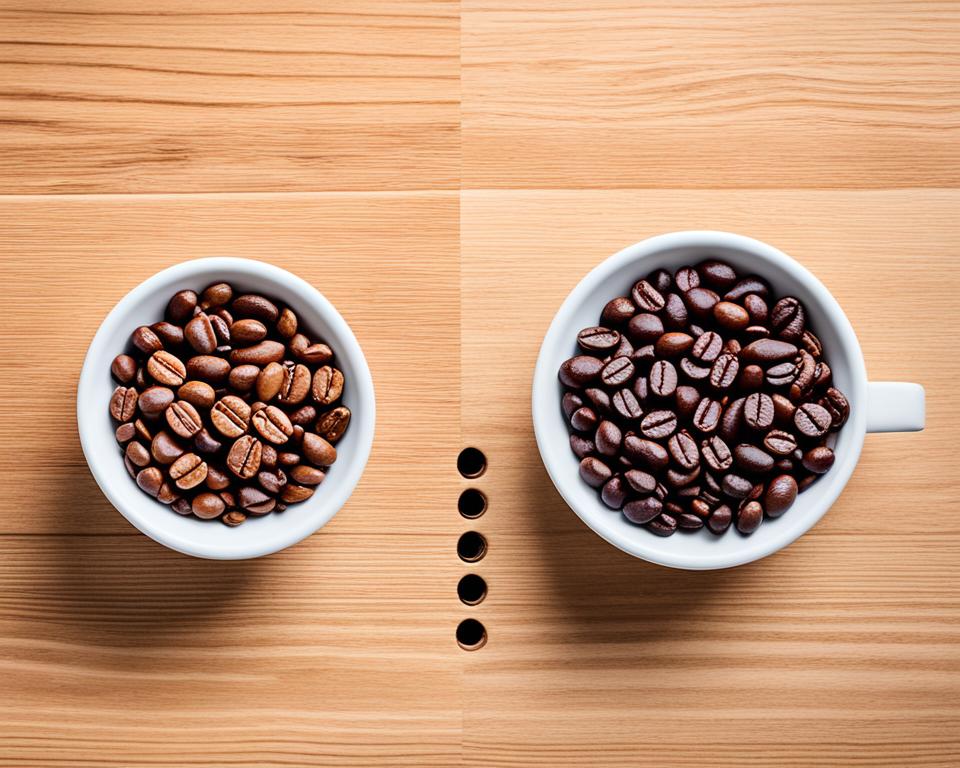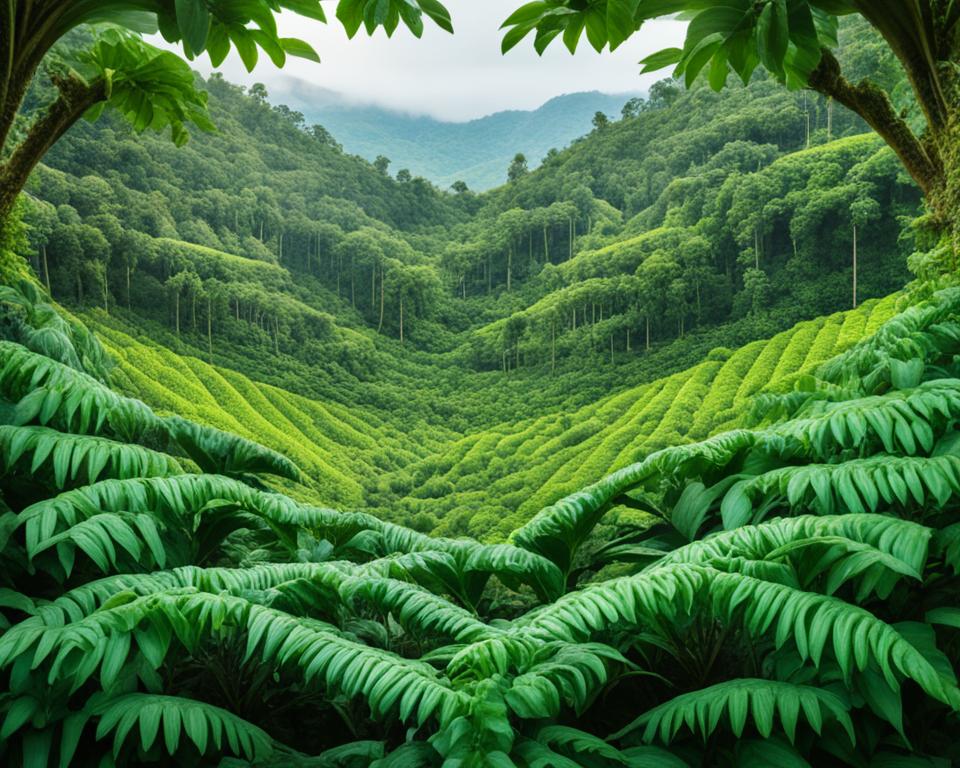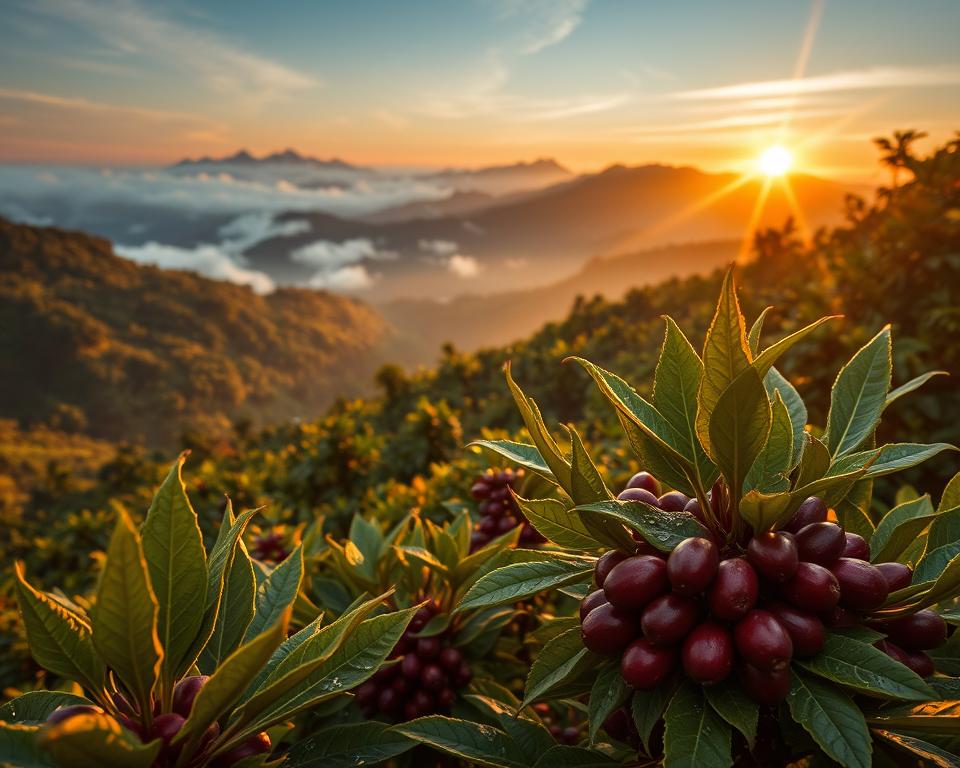Arabica coffee is very popular, making up about 60% of all the world’s coffee. In contrast, Liberia only makes up less than 2%. This shows how different these two types of coffee beans really are. Let’s explore the mysteries of Arabica vs. Liberica coffees. We will learn about their unique flavours, where they come from, and how they are grown.
If you love coffee or are just curious, it’s important to know the differences between Arabica and Liberica coffees. We’ll talk about their taste, how well they grow, and more. So, get your coffee mug ready. We are going on a journey to understand these fascinating beans.
Key Takeaways
- Arabica coffee represents 60% of global coffee production, while Liberica accounts for less than 2%.
- Arabica and Liberica coffee beans have distinct differences in taste, aroma, and flavour profile.
- The origins and history of Arabica coffee can be traced back to Ethiopia, while Liberica has roots in West Africa.
- Arabica coffee is generally preferred for its balanced acidity, whereas Liberica offers bold, fruity, and smoky flavours.
- Understanding the cultivation and growth conditions of both Arabica and Liberica beans highlights their unique farming requirements.
Understanding Arabica vs. Liberica: Origins and History
Exploring Arabica vs. Liberica origin takes us on a journey through rich history. It shows the deep cultural value these beans have. Coffee’s story is a mix of different places and times, making it truly fascinating.
The Journey of Arabica Coffee
Arabica coffee was first found in the ancient forests of Ethiopia. Known for its great taste and quality, it quickly spread. Traders carried it to Yemen, making it a hit there.
Then, it found its way to the Ottoman Empire and Europe, becoming a global favorite. Arabica’s top-grade status and rich history have made it beloved worldwide.
The Historical Roots of Liberica Coffee
Liberica coffee comes from the dense forests of West Africa. It thrived in tough conditions, earning a place of its own. Though not as famous as Arabica, it made its mark in Southeast Asia, in places like Malaysia and the Philippines. Liberica’s story shows a different aspect of coffee history.
Comparing the Historical Significance
Looking at both, the historical significance of coffee is very clear. Arabica has shaped the world coffee scene, affecting everything from how we drink coffee to its global trade.
Liberica, though less known, has played a key role in enriching the world of coffee and helping local economies.
| Coffee Type | Origin | Historical Spread | Cultural Impact |
|---|---|---|---|
| Arabica | Ethiopia | Yemen, Ottoman Empire, Europe, and the Americas | Global recognition, superior-grade status |
| Liberica | West Africa | Southeast Asia | Regional significance and economic impact in local areas |
Arabica vs. Liberica Taste and Flavour Profile
When looking at Arabica and Liberica beans, you’ll notice they offer very different tastes. This makes them special in the world of coffee lovers.
Each type presents a unique experience on the palette.
Aromatic Characteristics of Arabica
Arabica coffee is known for its pleasant smell. It has a good mix of sweet and tangy tastes, with complex flavors. You might notice flavours like berries, nuts, and flowers.
This makes Arabica a popular choice for its smooth and aromatic qualities.
Flavor Nuances of Liberica Coffee
Liberica coffee, on the other hand, has a bold and complex taste. It’s often called fruity, smoky, and sometimes woody. This unique mix appeals to those looking for a strong and bold coffee.
Perfect Brews: Arabica vs. Liberica Taste Comparison
The best way to enjoy Arabica is with gentle brewing methods. Pour-overs or French presses are great for bringing out their subtle flavors. These methods highlight its delicate taste.
For Liberica, stronger brewing is better. Espresso, or stovetop brewing, brings out its robust boldness. This makes its adventurous flavours stand out even more.
| Coffee Type | Typical Flavor Notes | Recommended Brewing Method |
|---|---|---|
| Arabica | Berries, nuts, floral | Pour-over, French press |
| Liberica | Fruity, smoky, and woody | Espresso, stovetop |
Arabica vs. Liberica Cultivation and Growth Conditions
When we look at Arabica vs. Liberica cultivation, it’s important to note their likes. Arabica coffee loves high altitudes, best between 1,200 and 2,200 metres up.
This area has the perfect climate, with temperatures ranging from 60°F to 70°F. These temperatures help the beans develop their delicate flavours and balanced acidity.
Liberica coffee, on the other hand, is tough, and people like it closer to the ground. It does well between 200 and 600 metres and can handle hot weather and variable rain. This strength makes Liberica the better choice for places where Arabica can’t grow as well.
Coffee growth conditions show that Arabica beans need a lot of attention. They need special soil and consistent watering. Farmers have to be on the lookout for pests and diseases.
Otherwise, these problems can hurt their crops badly.
Meanwhile, growing Liberica is easier but just as interesting. These plants are taller than Arabica and have bigger fruits. They need more space and a different way of trimming.
Even though it’s not as widely grown, it shows how well it can adapt to different soils and climates.
| Aspect | Arabica | Liberica |
|---|---|---|
| Optimal Altitudes | 1,200–2,200 meters | 200 – 600 meters |
| Temperature Range | 60°F–70°F | 80°F and above |
| Soil Requirements | Rich in organic matter | Varied, less specific |
| Attention Level | High, delicate care | Moderate, tolerant |
Arabica vs. Liberica: Caffeine Content and Health Impacts
Arabica and Liberica coffee offer different levels of caffeine and taste. This makes a difference in how they affect our health when we drink them.

Understanding caffeine levels in Arabic
Arabica coffee has less caffeine, around 1.2%, than other types. Its beans are known for having a lighter, sweeter taste. This makes it a good choice for those who are sensitive to caffeine but still want good flavour.
Exploring the Caffeine Content in Liberica
Liberica coffee has more caffeine, at about 1.8–2.0%. It’s known for being stronger and more robust. Some people love this bold flavor. But it might be too much for those who can’t have a lot of caffeine.
| Coffee Type | Caffeine Content | Flavor Profile |
|---|---|---|
| Arabica | 1.2% | Lighter, sweeter |
| Liberica | 1.8-2.0% | Stronger, more robust |
Health Implications of Drinking Arabica vs. Liberica
When it comes to our health, Arabica’s low caffeine can be better for some. It can reduce the risk of feeling anxious or having trouble sleeping. So, it’s a good choice for those who drink lots of coffee daily.
Liberica, with more caffeine, can give a bigger energy kick. Some people like this burst of energy. But this much caffeine raises the risk of feeling too anxious or having a fast heart.
Knowing the caffeine and flavor differences helps us pick what’s best for our health and taste preferences when choosing our coffee.
Which Coffee Type is Better: Arabica or Colombian, Based on Your Taste Test Verdict?
When exploring which coffee type reigns supreme, an arabica and colombian coffee comparison can offer delicious insights. Arabica beans tend to produce a smoother, more nuanced flavor profile, while Colombian coffee is known for its rich and bold characteristics. Your preference will ultimately guide you to the perfect brew.
Conclusion
Exploring Arabica and Liberica coffee beans shows each type has a special charm. We looked into their start, how they’re grown, tastes, caffeine, and effects on health. You’re more informed now to select the coffee that fits you best.
Arabica coffee is known for being smooth, with mild flavours and less caffeine. It is loved worldwide and costs more because of its careful growing process.
Liberica, on the other hand, has a strong taste and grows well in tough conditions. Although it’s not as easy to find, it offers a unique choice for those who love to try new things. Both Arabica and Liberica have their strengths, meeting different taste desires.
Arabica is the most popular coffee type everywhere, as evidenced by its wide preference and prices. Despite this, Liberica’s special taste can be a joy for those looking to break from the usual.
Deciding between Arabica and Liberica involves considering prices and flavors. Your choice between the two will make your coffee adventure more exciting. Whether you go for Arabica’s general appeal or Liberica’s unique flavours, you’re on a path to enjoying coffee in a new way.
FAQ
What are the main differences between Arabica and Liberica coffee beans?
Arabica beans have a smooth, mild taste with a bit of sweetness and fruitiness. They also have more acidity. Liberica beans taste bolder, with smoky and fruity hints. Arabica beans are oval and small. Liberica beans are bigger and have an irregular shape.
Where did Arabica and Liberica coffee originate?
Arabica coffee started in Ethiopia’s highlands. Now, it grows in many places around the globe. Liberica coffee began in West Africa, specifically Liberia.
How does the caffeine content of Arabica compare to that of Liberica?
Arabica coffee has less caffeine than Liberica. Arabica beans have 0.8–1.4% caffeine. This makes it a lighter, less bitter choice. Liberica beans have 1.8–2.0% caffeine, giving them a stronger taste.
What are the ideal growing conditions for Arabica and Liberica coffees?
Arabica grows best in high-altitude, tropical climates. It likes lots of rainfall and temperatures between 60 and 70 °F. It needs well-drained, fertile soil. Liberica can grow in warmer places at lower altitudes. It is harder to resist pests and diseases.
How do the flavor profiles of Arabica and Liberica coffees differ?
Arabica is known for its floral, fruity, nutty, and chocolatey notes. It also has a well-balanced acidity. Liberica has bold, fruity, and smoky flavors, offering a unique taste.
Why is Arabica coffee more popular than Liberica?
Arabica is more popular because of its smoother taste, which appeals to many. It’s widely available and has a long cultivation history. Liberica is less common due to its stronger, less preferred taste and limited production.
Are there any health benefits or drawbacks to drinking Arabica vs. Liberica coffee?
Both types have health benefits from antioxidants. For those who are sensitive to caffeine, Arabica might be a better choice because it has less caffeine. While Liberica can give a stronger energy boost, it may cause more caffeine-related issues if you drink a lot.




